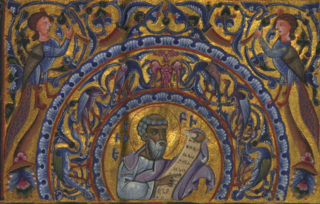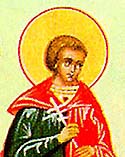
Eusebius of Caesarea, also known as Eusebius Pamphilus, was a Greek historian of Christianity, exegete, and Christian polemicist. In about AD 314 he became the bishop of Caesarea Maritima in the Roman province of Syria Palaestina. Together with Pamphilus, he was a scholar of the biblical canon and is regarded as one of the most learned Christians during late antiquity. He wrote Demonstrations of the Gospel, Preparations for the Gospel and On Discrepancies between the Gospels, studies of the biblical text. As "Father of Church History", he produced the Ecclesiastical History, On the Life of Pamphilus, the Chronicle and On the Martyrs. He also produced a biographical work on Constantine the Great, the first Christian Roman emperor, who was augustus between AD 306 and AD 337.
Agapius was a Christian martyr killed at Caesarea in AD 306. He is recognized as a saint by the Catholic Church. His martyrdom is recorded by Eusebius of Caesarea in his work The Martyrs of Palestine.

April 1 - Eastern Orthodox liturgical calendar - April 3
Saint Pamphilus, was a presbyter of Caesarea and chief among the biblical scholars of his generation. He was the friend and teacher of Eusebius of Caesarea, who recorded details of his career in a three-book Vita that has been lost.
Saints Theodora and Didymus are Christian saints whose legend is based on a 4th-century acta and the word of Saint Ambrose. The pair were martyred in the reigns of co-ruling Roman Emperors Diocletian and Maximianus. St. Theodora should not be confused with another St. Theodora of Alexandria commemorated on September 11.

The Diocletianic or Great Persecution was the last and most severe persecution of Christians in the Roman Empire. In 303, the emperors Diocletian, Maximian, Galerius, and Constantius issued a series of edicts rescinding Christians' legal rights and demanding that they comply with traditional religious practices. Later edicts targeted the clergy and demanded universal sacrifice, ordering all inhabitants to sacrifice to the gods. The persecution varied in intensity across the empire—weakest in Gaul and Britain, where only the first edict was applied, and strongest in the Eastern provinces. Persecutory laws were nullified by different emperors at different times, but Constantine and Licinius' Edict of Milan in 313 has traditionally marked the end of the persecution.

·

Romanus of Caesarea is venerated as a martyr. A deacon of Caesarea, he was martyred at Antioch.

Aphian is venerated as a martyr by the Catholic Church and by the Eastern Orthodox Church. He is said to have died during the persecutions of the Emperor Galerius on April 2 in or around the year 305. In the Eastern Orthodox calendar, his feast thus falls on April 2, along with Edesius (Aedisius), who is sometimes called his brother.
Elias and four companions, Daniel, Isaiah, Jeremiah, and Samuel were Egyptian martyrs. Their feast day is February 16.
Basilides and Potamiaena were Christian martyrs now venerated as saints. Both died in Alexandria during the persecutions under Septimius Severus.

Procopius of Scythopolis was a 4th century martyr who is venerated as a saint. He was a reader and exorcist in the church at Scythopolis; he also was famous as an ascetic and erudite theologian. Eusebius of Caesarea wrote of his martyrdom, which occurred during the persecution of Roman Emperor Diocletian, and stated that "he was born at Jerusalem, but had gone to live in Scythopolis, where he held three ecclesiastical offices. He was reader and interpreter in the Syriac language, and cured those possessed of evil spirits." Eusebius wrote that Procopius was sent with his companions from Scythopolis to Caesarea Maritima, where he was decapitated.

Dorothea of Caesarea is a 4th-century virgin martyr who was executed at Caesarea Mazaca. Evidence for her actual historical existence or acta is very sparse. She is called a martyr of the late Diocletianic Persecution, although her death occurred after the resignation of Diocletian himself.
Sossianus Hierocles was a late Roman aristocrat and office-holder. He served as a praeses in Syria under Diocletian at some time in the 290s. He was then made vicarius of some district, perhaps Oriens until 303, when he was transferred to Bithynia. It is for his anti-Christian activities in Bithynia that he is principally remembered. He was, in the words of the Cambridge Ancient History, "one of the most zealous of persecutors". While in Bithynia, Hierocles authored Lover of Truth, a critique of Christianity. Lover of Truth is noted as the first instance of the trope, popular in later pagan polemic, of comparing the pagan holy man Apollonius of Tyana to Jesus Christ.

November 12 - Eastern Orthodox liturgical calendar - November 14

December 9 - Eastern Orthodox liturgical calendar - December 11

Saint Theodosia of Tyre, according to the historian of the early Christian church Eusebius, was a seventeen-year-old girl who deliberately sought to be executed as a martyr to Christianity in the city of Caesarea in 307 AD. She was tortured, urged to reject Christianity, and, when she refused, thrown into the sea. She is commemorated on April 2.

Saint Timolaus and five companions, according to the historian of the early Christian church Eusebius in his Martyrs of Palestine, were young men who, having heard that the Roman authorities in Caesarea, Palestine, in 303 AD, had condemned a number of Christians to die by being thrown to wild beasts in the public arena, came before the governor of their own volition with their hands tied behind their backs and demanded to join their fellow Christians in that martyrdom. They were not however thrown to wild beasts but decapitated along with two other men who were already in prison.
Saint Ulphianus was a Christian martyr in Palestine. His feast day is 3 April.

This article lists historical events that occurred between 301–400 in modern-day Lebanon or regarding its people.